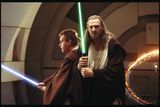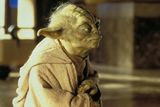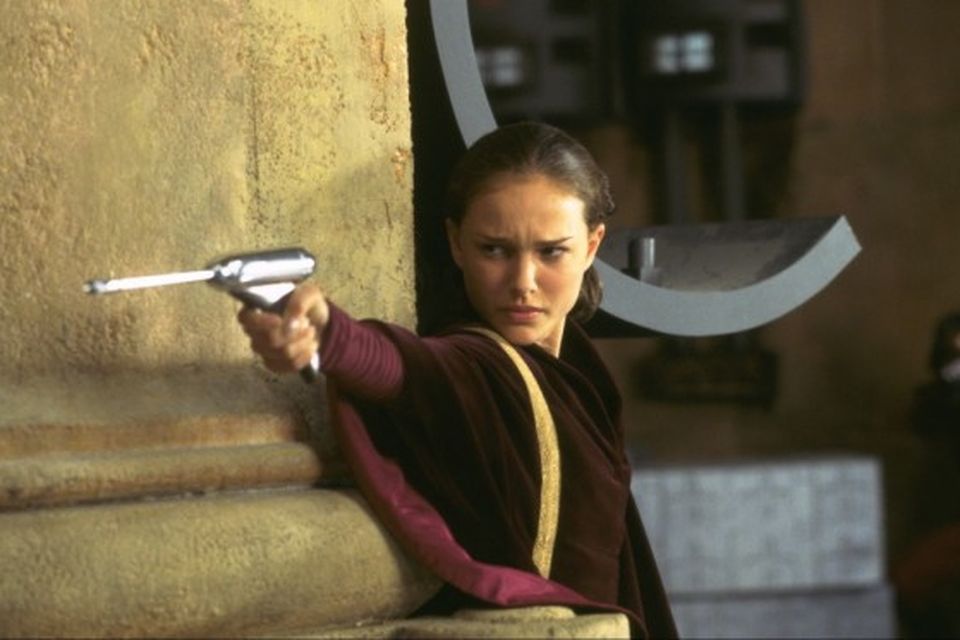Sneer all you like, but the Star Wars prequels got one big thing right
The Phantom Menace, Attack of the Clones and Revenge of the Sith have been charged with ‘ruining childhoods’ but they offered better entertainment than many of the reboots and spinoffs that followed in the 25 years since



With it being the 25th anniversary of The Phantom Menace — and the movie once again showing in Irish cinemas — I have a confession to make: I have a soft spot for the Star Wars prequels.
Now, this confession usually prompts concerned responses from friends and family, inquiring whether I have experienced a sudden blow to the head. That’s understandable.
The prequels exist in the cultural memory as the punchline, spectacular blockbuster follies that led to decades of fans complaining George Lucas had “ruined their childhood”.
I’m not here to make an argument that these films are misunderstood masterpieces or are “like poetry, sort of”. The criticisms are well-deserved. The actors are out of their depth. The dialogue is horrific. Harrison Ford was right to tell Lucas during the original trilogy: “You can write this shit, but you can’t say it.”
The Phantom Menace in particular is populated with enough crude racial caricatures to make Indiana Jones and the Temple of Doom feel like it just attended a workplace seminar on inclusivity.
And yet we inevitably return to that hazily defined “soft spot”. To be clear, this isn’t nostalgia. No fan in their right mind longs to take a time-warp back to opening night of The Phantom Menace so they can experience that crushing disappointment anew.
If anything, it’s the opposite. The Star Wars prequels have aged well because how firmly they contrast with so many of the films and television shows that followed, more than two decades of brand extensions.
Yoda is a returning character in the Star Wars franchise
The Phantom Menace heralded the future, signalling open season on classic properties. Studios were no longer confined to sequels to their beloved brands, but could now make prequels.
The prequel then gave way to the reboot. Nothing was ever truly over. No idea was ever truly exhausted. A successful franchise could keep churning out new material to lure fans back to the cinema and keep shareholders flush with cash.
In the years following The Phantom Menace, Hollywood embraced nostalgia. There were reboots of Planet of the Apes and James Bond, an endless churn of Terminator sequels without James Cameron, three separate cinematic Spider-Man franchises and an X-Men franchise that rebooted and then debooted and then re-rebooted itself. Today, media companies just pump endless supplies of branded “content” directly into our homes.
To be clear, some of this material is great. Christopher Nolan’s Dark Knight trilogy marked a welcome improvement on Joel Schumacher’s Batman sequels. Just last year, Greta Gerwig directed the best ever toy commercial with Barbie.
Even in terms of prequels, the recent Planet of the Apes trilogy was a recent standout in terms of branded entertainment. But in recent years it has become exhausting.
Much of this feels familiar and uncanny. Wary of potential online backlash, studios have become protective of their core franchises. Reheats are on the menu.
Read more
Perhaps eager to avoid a reaction similar to that which greeted the prequels, JJ Abrams’ The Force Awakens was basically a remake of the original Star Wars. The Mandalorian is a Star Wars streaming show about a guy who looks like Boba Fett, promptly followed by The Book of Boba Fett, about a guy who is Boba Fett.
Consider the Star Trek franchise. In 2001, it launched a prequel series, Enterprise. In 2009, it launched a reboot movie franchise featuring a younger version of Kirk (Chris Pine). In 2017, it returned to television with Discovery, a show focusing on Spock’s secret human sister, Michael (Sonequa Martin-Green).
It followed this up with Picard, which turned into a Next Generation revival, and Strange New Worlds, another prequel featuring another version of Kirk (Paul Wesley).
Last summer, Michael Keaton returned as Batman in The Flash and Harrison Ford picked up the bullwhip again for Indiana Jones and the Dial of Destiny, to a collective sigh of indifference. The actors reprised iconic roles, but without the directors who made their earlier work so memorable.
Natalie Portman in a scene from the movie
Last month, Ghostbusters: Frozen Empire thawed out another 1980s franchise to ask, “What happens when busting doesn’t make you feel good? What happens when it leaves you feeling nothing at all?”
Flicking through the streaming apps, it’s hard not to feel numb. Netflix offers live action adaptations of anime such as Cowboy Bebop, One Piece and Avatar: The Last Airbender, replaying the plots of those shows but stripping out the idiosyncrasies of animation.
Paramount+ dug in its vaults and brought back steamy erotic thrillers American Gigolo and Fatal Attraction as limp curiosities. Key scenes are replayed, beloved lines are repeated, but it all feels like a photocopy of a photocopy of a photocopy.
Who is any of this for? Who is the target market? Michael Keaton’s Batman movies and Harrison Ford’s Indiana Jones movies were huge hits with young kids.
Ghostbusters imprinted itself on a generation of teenage boys. The original Star Wars is a cherished childhood memory for millions of people. Watching the new Ghostbusters, I found my eyes drifting to the audience: bored kids sitting next to adults with looks of dull recognition on their faces.
For all of the myriad flaws with the Star Wars prequels, they were never this lifeless. Those three films never felt like the work of an algorithm churning out content designed to minimise the risk of online backlash
For all of the myriad flaws with the Star Wars prequels, they were never this lifeless. Those three films never felt like the work of an algorithm churning out content designed to minimise the risk of online backlash.
Sure, there were returning characters like Yoda (Frank Oz) and Obi-Wan Kenobi (Ewan McGregor), but they embraced an entirely new aesthetic, trading the gritty “used future” look of 1970s sci-fi for the shiny cartoon retro-futurist veneer of 1950s pulp fiction.
So much modern Star Wars is just the aesthetic of the original films copied-and-pasted. For all that Luke (Mark Hamill) couldn’t wait to get away from Tatooine, modern Star Wars can’t wait to get back there.
The Mandalorian is an endless collection of desert worlds, ice planets and forest moons. In contrast, the prequels offer medieval courts, city planets, water worlds and more. Are any of John Williams’ compositions for the sequels as memorable as Duel of the Fates or Across the Stars?
The prequels reflected the sensibilities and interests of George Lucas, a film-maker who is — and I say this with genuine affection — a bit of a weirdo with a unique perspective.
They had things to say about the world, with the second and third allowing Lucas to confront the War on Terror in a way that few contemporary blockbusters could.
They didn’t do this with the eloquence or sophistication of something like The Dark Knight, but they did far more than most recent franchise fare.
More profoundly, the prequels knew who they were for. They were never intended for people who saw the original Star Wars movies as artifacts of their youth to be protected and preserved.
As much as adult fans grumbled about Jar-Jar Binks (Ahmed Best) and Anakin (Jake Lloyd) in The Phantom Menace, the inclusion of those characters spoke to who the movie was for: children.
Indeed, a large part of the modern reclamation of the prequels is those younger viewers coming of age.
Now, were these good children’s movies? No, not at all. However, they were more interested in speaking to kids who were 12 than to appealing to adults who wished to be 12 again. That’s something worth being nostalgic about.
‘Star Wars: Episode I — The Phantom Menace’ is now showing in cinemas
Join the Irish Independent WhatsApp channel
Stay up to date with all the latest news



















